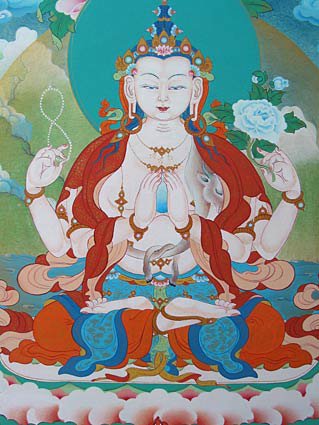
The first time I went to India, I didn’t know it would be three years before I returned my home country. During my time there, I felt that no day was like another, yet something each day in the background: the mantra “om mani padme hum,” which was chanted continually in the streets of Dharamsala, the home of the Tibetan community in exile and His Holiness the Dalai Lama in northern India. It became commonplace and I probably even underestimated its depth until I decided to understand why this is the most precious mantra in Tibetan Buddhism, dedicated to the Buddha of Compassion, Chenrezig (Avalokiteshvara).
The mantra is usually written horizontally in beautiful Tibetan calligraphy, but I like to visualize the mantra written over the structure of a lotus flower mandala, as it is sometimes depicted. A mandala is itself a perfect symbol of compassion: the simple circle symbolizes the continuum of life and the interdependence between us all; we are all part of the same world—the same organic body called planet Earth.
To understand compassion is to first understand that we all live in the same world. We can then take a step further to understand that we share the same heart as well: if one being is suffering it will, sooner or later, interfere in my life as well; there is no separation. There is no such thing as isolated happiness or goodness, as such virtues manifest between the relationship of being with another, or one being with the environment, with nature, or even simply with the sky. Compassion is born of the relationship with another. A mandala basically means one; the common source of all. When we understand that we come from the same source, the same origin, there can be no separation, comparison, judgment, racism, or war.
Tibetan Mandalas usually depict a deity in the center, with the mandala a tridimensional temple in which the deity abides. Qualities such as compassion cannot be visually grasped, but can be accessed by any being from any part of the world; it can have many names and perhaps many faces, but we know when compassion is being manifested. Jung referred to such beings a means of accessing the archetypes. For example, Chenrezig can be described as the archetype of pure compassion. To understand a bit more about archetypes, I’d like you to imagine a tree—and I, too, will imagine a tree. It’s unlikely that we both saw the same tree in our mind’s eye. Maybe you saw an oak tree, very different from the palm tree in my mind? Yet both of us accessed somewhere in the mind we share, the archetype of trees. We can do the same with qualities such as courage, compassion, and love, but also with war, aggression, greed, power, and so on. That is why we have myths and legends, which, in truth, are talking not about the story of a single being, but the potent quality of the “god” or “goddess” unfolding in different ways in our lives. When we visualize the Buddha of Compassion, for example, and repeat his mantra, we are indeed connecting to the universal archive we all share, making it possible to follow this path. Through the practice of visualization, mantra recitation, and other specific practices, we can refine our connection to that pure source of the archetype we sometimes access without even knowing. This access can be made consciously, sculpted in each action and word until we become the source itself—as in the case of many enlightened masters. When we come close to them, we know it.
Unfortunately, this access to the many archetypes we share as humankind can be manipulated by greed to serve a capitalist society. So in this practice it is essential, today more than ever, to be conscious about what we are connecting to, as we can access many kinds of “deities”—some for liberation, while to some we become slaves. Awareness should be our clearest responsibility on the path of compassion.

The sanskrit mantra “Om mani padme hum” is already a landscape of the buddha-mind. Let me show this vision by diving into its meaning, word by word and syllable by syllable, as I have heard explained by many teachers, such as Ven. Guan Cheng and Ponlop Rinpoche.
OM cannot be translated as a word, only as a vibration. Om is used at the beginning of basically all mantras and prayers and there is so much that we can explore about its meaning. Here I’d like to consider the element of sound as in many old texts, such as the Vedas and the Bible, which describe how “in the beginning” there was the word or the sound. Before matter, there was vibration, a frequency organizing particles to be placed together or apart. Om opens to a specific universe as it opens to a mantra: to the world of the deity, the archetype, the common archive, also called the Akash.
MANI means jewel. If you look at the image of Chenrezig, you will notice that he has four arms and the hands of two of the arms hold in front of his heart a jewel. One other has a lotus flower (padma) and the other a japa-mala (mantra garland). This buddha is totally connected to this mantra. The jewel symbolizes that which we hold as the most precious in ourselves—the diamond that when sculpted and polished (the cultivation of bodhicitta) will shine and serve as a gift of inspiration and benefit to other beings. The jewel is here to remind us to cultivate the best in ourselves and that this act lies in our own hands. It’s our responsibility; our only “savior” is our own commitment to practice and polish our qualities to shine like a diamond. As I noted before, we can access all kinds of “gods” in the common mind, and to choose Chenrezig, for example, is to commit to the best in you with the intention to benefit all other beings, who are not separate from you anyway. Mani combined with padma also relates to the inseparability of wisdom and compassion, which, on the path of cultivating bodhicitta, should be symmetrically related, like the two wings of a bird. Compassion without wisdom easily falls into pity and to only immediate actions, without perceiving the consequences, whereas with wisdom one acts with the vision of the past and future; it is patient and courageous. Wisdom without compassion can easily fall into intellectualization, freezing the mind from taking any true action. That is why in Tibetan Buddhism, compassion in this context is also called “skillful means,” because compassion moves mountains, as some say, and with wisdom it moves to the most efficacious place.
PADMA means lotus. Such a wonderful symbol! It is one of the most beautiful flowers and springs from the mud, meaning beauty springing from samsara. No matter where you are, into which dark, muddy waters you dive, there are always the dormant seeds of virtue within. It is so common to hear about people who are surprised by an illness or a heartbreak, finding themselves in deep, dark waters, only to then discover their enormous strength and love for life and passion for living. Such a perspective on the world is a gift, as beauty truly lies in the eye of the beholder. When one has questioned life and in some shaky moment is able to choose life because one sees the beauty in it, it’s like an awakening. It’s like the moment when the lotus breaks through the surface of the dark waters and becomes an offering that penetrates infinite space. The lotus inspires me so much that I have created an art project of guiding groups or individuals in artistic immersions in nature to awaken the artist within, touching its own suffering and transforming it into an offering to the world so that their art becomes an instrument of awakening. We all have the seeds of many lotuses, because all of us are of mud and sky. Look again at Chenrezig’s image. He is sitting on a lotus throne. All enlightened beings in Tibetan art sit upon a lotus, meaning they have found strength in the midst of suffering—the committed compassion, love for life and for all beings, the capacity to see beauty in all and to serve as an offering for all beings. Perhaps in the godly realm, where everything is eternal, secure, comfortable, and beautiful, one does not have the chance to develop such qualities with so much determination and radiance. In a way . . . the capacity we have to hold suffering (our own or that of others) is our capacity to sculpt our heart in the shape of compassion.
HUM doesn’t have a literal translation and usually encloses a mantra. I have also heard that hum is like the seed itself, once the mantra is pronounced, it is planted deep within our hearts with “hum.”

“Om mani padme hum” can also be contemplated with its six syllables: om-ma-ni-pad-me-hum (and when in a mandala, the syllable “hri” is written at the center, as the seed syllable of the deity itself, like Chenrezig in this case). The six syllables can correspond to the six paramitas and the six realms of existence. I will share here as I understand from my own perception. Surely a proper Dharma teacher can take you even deeper into understanding and practicing the paramitas.
The paramitas, or Six Perfections, can be described like a manual of the Buddha’s teaching—remember that between so many “gods” to follow, the Buddha named some specific for us to access and cultivate so we do not waste time being lost with other “gods.”
The Six Perfections are: Generosity, Discipline, Patience, Diligence, Meditation, and Wisdom.
In this context, the first syllable “OM” is related to the paramita of generosity. Let’s not limit the idea of generosity to simply giving something, or being abundant to be able to give, but also to being empty enough to receive others as they are, to truly listen, to truly embrace and hold space. When one is in deep suffering, a generous friend doesn’t come with his or her own agenda, but comes to hold space for the other. And for that, one has to be empty of one’s own desires. To be joyfully present is the biggest, rarest, and most valuable gift anyone can give.
MA. Discipline. My teacher in India used to say that discipline is freedom. It took me a while to understand but it soon became my “slogan.” Once we tame our minds, as we might tame a wild horse, we become masters of these muscles, not slaves or victims. That mastery is freedom and can be attained only through discipline.
NI. Patience. Patience took me long time to appreciate, and to not mix with passivity or forced silence. It was the muddy water of space and time that actually taught me that a true and mature warrior is not always in action, proving his or her strength and power, winning golden medallions or dying in battle. Rather, that silent gardener, birds-in-spring watcher, baker, reader, silent burning heart and radiant eye that moves in rhythm with the breath of all the trees and all the birds and stars, with a clear vision of the target reached by a single arrow with no effort and at just the right time. No energy at all is wasted by the patient warrior. He or she waits for the Earth and the sky to be in their favor. To know the Earth and the sky, one has to be humble and quiet because no one can go against nature, but can wait until it’s on one’s side. Once this truth is our truth, there is nothing that we can’t do. This takes us to the next paramita, diligence.
PAD. Diligence also has much to do with humility. When we do not work against things, but understand, for example, the nature of a huge wave, one can choose to surf the wave, rather than try to destroy or run from it. One has to be persistent with joy, because only a joyful surfer can understand the wave and see it not as an obstacle but as an opportunity and an adventure, taking the best out of any circumstance. We have the feeling that things are going against us when we have the wrong view or persist with the wrong intention. Persistence is not to force, but to cultivate a calm certainty of clear motivation, not being corrupted by fear or opinions.

ME. Meditation. To come to a state of patience and diligence, one has to practice meditation, which basically is to see things as they are, without definition by any opinion or distortion by any emotion. It is to feel the emotion without freezing it in any conclusion. To really be able to observe things as they are. If we dive into the dark mud (which we involuntarily do on occasion) the practice of meditation can offer us distance from all the stories; we build a harbor in our hearts, to which we can always return and rest in awareness. Meditation, it should be noted, is not limited to sitting crosslegged, but can also be found in washing dishes, listening to others, driving, cooking, making love. It’s really about being present without judgments, which take you away from the present and the essence of all experience.
HUM. Only when you are able to be present with the essence of all experience can you reach the heart of life and be one with it, with no separation or preconceptions. This kind of wisdom has nothing to do with how many books you read or how many countries you travel to. Many times the Dharma exhales silently from an enlightened person. Wisdom is a deep respect and humility toward the forces of nature, and a deep understanding that we are made from the earth and to the earth we will return. What rushes through my bones is not “me” but that same life that rushes in “you”—there really is no separation. With no separation, compassion arises naturally, with no effort, like a lotus from the center of a broken heart.
I’d like to conclude with a quote from Chogyam Trungpa Rinpoche:
To be a spiritual warrior, one must have a broken heart; without a broken heart and the sense of tenderness and vulnerability, your warriorship is untrustworthy.
May this time of viruses and war sculpt the jewels of compassion lying within our dormant hearts. May suffering serve as the wood that feeds the fire toward liberation. Let our joy be our rebellious song for the love of life, and may our lives be an offering of beauty and goodness for the benefit all beings.
If you would like to learn how to draw and paint the Mandala of Compassion, please check out my online course.
See more
Related features from BDG
The Proportions of Life
Remembering a Dance That Came in a Dream
Art, Culture, and Healing the World: A Conversation with Haema Sivanesan














